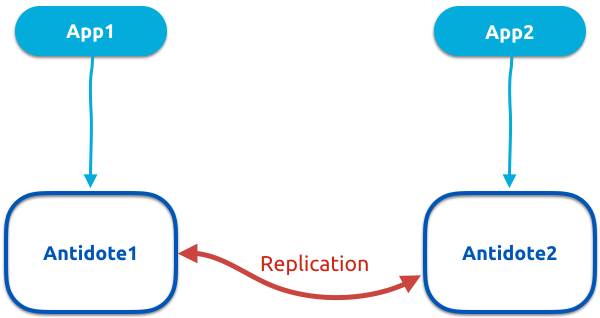This is a sample application to demonstrate how to build applications that use AntidoteDB as backend database.
This tutorial is made for Antidote Bookstore Tutorial
- Docker
- docker-compose
- An IDE for java development
git clone https://github.com/AntidoteDB/antidote-java-tutorial
This repository is divided into two source directories:
setup: scripts and docker files for running two instances of Antidote and two instances of the Java applicationbookstore: source of the tutorial application
| Note: make sure you have the software requirements listed above before following next steps. |
|---|
The following script starts two antidote docker containers and set up the inter-dc replication.
# in setup/
./start_antidote.shThe interactive tutorial is an executable that presents a series of tasks/challenges. Each task has an outcome, SUCCESS or FAIL. Solving a task allows you to try out the next task. To try the interactive tutorial:
Open a new shell:
# in setup/
./tutorial_setup.sh
# build the tutorial
root@tutorial$ ./gradlew build
# run the tutorial executable
root@tutorial$ ./tutorial.shIn case you want to reset your progress:
# in setup/
./stop_antidote.sh
./start_antidote.sh| Note: Solving the interactive tutorial is equivalent to following steps 3, 4 and 5 bellow. Alternatively, you can skip this step and go directly to step 3. |
|---|
Open two shells:
- In the first one, start the first app:
# in setup/
./app1_setup.sh
# build the app code
root@app1$ ./gradlew build
# and start the app
root@app1$ ./app1.sh
# then connect the app to Antidote instance 1:
bookstore@antidote1 > connect antidote1 8087- We will do the same for the second app:
# in setup/
./app2_setup.sh
# build the app code
root@app2$ ./gradlew build
# and start the app
root@app2$ ./app2.sh
# then connect the app to Antidote instance 2:
bookstore@antidote2 > connect antidote2 8087We have now deployed this configuration:
Some commands are already implemented in the app, lets try them:
bookstore@antidote> inc testbucket mycounter
bookstore@antidote> getcounter testbucket mycounter
bookstore@antidote> additem testbucket myset newitem
bookstore@antidote> getset testbucket myset
To stop the app:
bookstore@antidote> quit
You can also try to disconnect Antidote servers to simulate network partitions, commit some concurrent updates, then reconnect to merge CRDTs:
# in setup/
./disconnect.sh #to disrupt communication between Antidote1 and Antidote2 nodes
#then update objects while disconnected
./connect.sh #connect Antidote nodes backTo stop the two Antidote Nodes:
# in setup/
./stop_antidote.shWe now want to build our Bookstore app. The provided sources are divided into 3 files (located in bookstore/src/main/):
BookStore.java: this file contains the command interface and the starting point of the app.DemoCommandsExecutor.java: this file contains the implementation of the demo commands we have seen in the previous Step. You can use them as examples to implement your own commands.BookCommands.java: Here is the file where you need to implement Bookstore commands, fill in the methods to add necessary.
The main method is located at bookstore/src/main/java/BookStore.java.
To re-build the app after modifying the source code:
some_docker_container$ ./gradlew buildwhere some_docker_container may be:
root@app1orroot@app2orroot@tutorial
Some useful references:
View license information for the software contained in this image.
